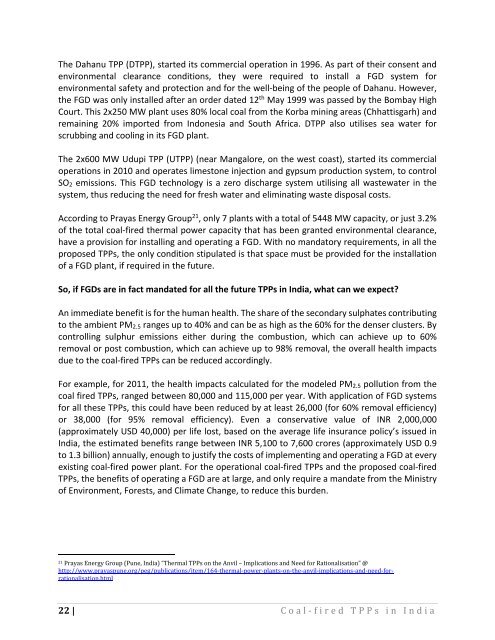Coal Kills
1TndvUf
1TndvUf
You also want an ePaper? Increase the reach of your titles
YUMPU automatically turns print PDFs into web optimized ePapers that Google loves.
The Dahanu TPP (DTPP), started its commercial operation in 1996. As part of their consent and<br />
environmental clearance conditions, they were required to install a FGD system for<br />
environmental safety and protection and for the well-being of the people of Dahanu. However,<br />
the FGD was only installed after an order dated 12 th May 1999 was passed by the Bombay High<br />
Court. This 2x250 MW plant uses 80% local coal from the Korba mining areas (Chhattisgarh) and<br />
remaining 20% imported from Indonesia and South Africa. DTPP also utilises sea water for<br />
scrubbing and cooling in its FGD plant.<br />
The 2x600 MW Udupi TPP (UTPP) (near Mangalore, on the west coast), started its commercial<br />
operations in 2010 and operates limestone injection and gypsum production system, to control<br />
SO 2 emissions. This FGD technology is a zero discharge system utilising all wastewater in the<br />
system, thus reducing the need for fresh water and eliminating waste disposal costs.<br />
According to Prayas Energy Group 21 , only 7 plants with a total of 5448 MW capacity, or just 3.2%<br />
of the total coal-fired thermal power capacity that has been granted environmental clearance,<br />
have a provision for installing and operating a FGD. With no mandatory requirements, in all the<br />
proposed TPPs, the only condition stipulated is that space must be provided for the installation<br />
of a FGD plant, if required in the future.<br />
So, if FGDs are in fact mandated for all the future TPPs in India, what can we expect?<br />
An immediate benefit is for the human health. The share of the secondary sulphates contributing<br />
to the ambient PM 2.5 ranges up to 40% and can be as high as the 60% for the denser clusters. By<br />
controlling sulphur emissions either during the combustion, which can achieve up to 60%<br />
removal or post combustion, which can achieve up to 98% removal, the overall health impacts<br />
due to the coal-fired TPPs can be reduced accordingly.<br />
For example, for 2011, the health impacts calculated for the modeled PM 2.5 pollution from the<br />
coal fired TPPs, ranged between 80,000 and 115,000 per year. With application of FGD systems<br />
for all these TPPs, this could have been reduced by at least 26,000 (for 60% removal efficiency)<br />
or 38,000 (for 95% removal efficiency). Even a conservative value of INR 2,000,000<br />
(approximately USD 40,000) per life lost, based on the average life insurance policy’s issued in<br />
India, the estimated benefits range between INR 5,100 to 7,600 crores (approximately USD 0.9<br />
to 1.3 billion) annually, enough to justify the costs of implementing and operating a FGD at every<br />
existing coal-fired power plant. For the operational coal-fired TPPs and the proposed coal-fired<br />
TPPs, the benefits of operating a FGD are at large, and only require a mandate from the Ministry<br />
of Environment, Forests, and Climate Change, to reduce this burden.<br />
21 Prayas Energy Group (Pune, India) “Thermal TPPs on the Anvil – Implications and Need for Rationalisation” @<br />
http://www.prayaspune.org/peg/publications/item/164-thermal-power-plants-on-the-anvil-implications-and-need-forrationalisation.html<br />
22 | <strong>Coal</strong>-fired TPPs in India




